It was fifty years ago that those four lads from Liverpool took the United States by storm with a blend of rock-and-roll and Tin Pan Alley that made young women swoon and made James Bond beg for earplugs. (Seriously; Sean Connery’s Bond dissed The Beatles in Goldfinger.) For the next several years, the Fab Four churned out album after album, playing a large role in redefining pop music. Alas, it was over in 1970; the band broke up and fans were enjoined to “Let it Be.”
Whenever I think about pop culture issues, I try not to be a stick in the mud. I am aware that my disdain for the “music” of Nicki Minaj is the same pain felt by parents who heard their children blasting “Love Me Do” from their bedrooms. Many contemporary critics were annoyed by Frank Sinatra in the same manner that One Direction’s “music” irks me. Each new generation will have their own clothing and music and language. I get it. Creative people, of course, do their best to understand the craft and ideas behind all kinds of human expression, regardless of era. Our focus, of course, should remain closest on timeless works that define and defy the times in which they were created.
Writers must understand the passion behind Beethoven’s Ninth Symphony and they should learn what they can from The Beatles. Here are just ten lessons in writing craft that John, Paul, George and Ringo have to teach us:
1. Repetition is powerful and allows you to get a big affect out of small changes. - “I Saw Her Standing There” (Lennon/McCartney)
Can you believe that this is the first song that Lennon and McCartney wrote together? Amazing. Now, the song flat-out makes you want to move, so you may have missed a cool trick that Paul and John played with the lyrics. Like many of the Beatles’ early love songs, the rhymes and the concept aren’t very complicated. The narrator sees a beautiful woman across the dance floor. Got it. The rhymes? “Boom/room.” “Night/tight.” “Me/see.” (Well, I will admit that “seventeen” and “what I mean” make a pretty cool cretic rhyme.) The chord structure is pretty darn simple: a basic rock I-V with a few IVs thrown in. None of this is a knock; simple can definitely be awesome. Besides, don’t we all want a love life that is as easy as “I Saw Her Standing There?”
Importantly, the simplicity of the song allows the few complicated elements to take center stage and to have a much bigger effect. Don’t you love the playful, insistent bass line all the more because George’s rhythm guitar part is so simple?
Writers will want to take a look at a lyrical move that John and Paul make at the end of each verse. I believe that I noticed this cool bit myself a long time ago, but I’m a big fan of Alan W. Pollack’s Beatles scholarship, so I’m happy to give the gentleman a shoutout either way. Go see his site. It’s awesome.
VERSE 1: How could I dance with another when I saw her standing there?
VERSE 2: She wouldn’t dance with another when I saw her standing there.
VERSE 3: Now I’ll never dance with another since I saw her standing there.
Paul keeps the music chugging along with that exciting bass line and uses the words to add momentum, too. The changes I’m pointing out create a narrative. In the first verse, the woman is a stranger to the narrator. Eventually, he asks her to dance and she begins to develop reciprocal feelings. In the third verse? The coupling is formalized; the narrator proclaims his joy that he’s found a mate. The listener is grabbed because, inspired by these small changes in the context of repetition, he or she subconsciously wants to see what happens to a character who expresses longing.
2. Experiment by writing in the voice of an author you admire. - “You’ve Got to Hide Your Love Away” (Lennon/McCartney)
Isn’t that music video beyond charming? If you listen to John’s pinched tone and the circuitous nature of the verses, you’ll definitely hear the influence of Bob Dylan. (Who seems to have introduced the boys to some other things, too.) Compare “You’ve Got to Hide Your Love Away” to an early Dylan hit that was likely swirling around in John’s head in 1965:
What was one of John’s intentions when composing the song? Here’s what Paul said in a 1980s Playboy interview:
That was John doing a Dylan-heavily influenced by Bob. If you listen, he’s singing it like Bob.
We each have our own unique voices as writers, but what happens if you play around and pretend to be someone else for a little while? (In John’s case, you get a hit song.) Look back at the body of your work to see what kinds of themes and archetypes and even words you usually use. What would happen if you try ditching some of those crutches? I’ve done this in my own work. For reasons that are obvious to anyone who knows me, I tend to write about unrequited love and characters who feel abandoned. For the past couple years, I’ve tried to play around with other themes and other tones in the same way that John wanted to see what it would be like if he ditched some of the bright tone of his previous songs and tried a chug-chug-chug folk song in 3/4.
If you write romance stories, why not consider writing a hard-boiled crime story to see what your voice sounds like when you’re describing murder instead of love? (Here are some cool audio renditions of stories from Ellery Queen.) Say you love Alice Munro, but most of your work is more like the horror output of Stephen King. What would happen if you try to write your own “Munro” story?
3. Find a writing partner or first reader who complements you well. - “Getting Better” (Lennon/McCartney)
One of my many writing-related regrets is that I never found a writing partner. Can I do a lot on my own? Sure. But I love what a partnership can do and how the whole can be bigger than the sum of its parts. Lennon and McCartney pushed each other with the friendly competition they shared. I’m a longtime fan of The State; Tom Lennon and Robert Ben Garant have done some amazing things in collaboration.
An honest and occasionally brutal writing partner or first reader can tell you where you’ve gone wrong and can even contribute to the final product in meaningful ways. “Getting Better” is a great example as to how the Lennon/McCartney partnership resulted in a better song than would have emerged had Paul been on his own. It’s too simplistic to say that Paul was the “happy/melodic” one and that John was the “melancholy” one focused on creating an atmosphere and evoking emotion. In this song, however, you have a great example of how the two men came together. Here’s what Paul said about the song in that Playboy interview:
PAUL: Wrote that at my house in St. Johns Wood. All I remember is that I said, “It’s getting better all the time,” and John contributed the legendary line “It couldn’t get much worse.” Which I thought was very good. Against the spirit of that song, which was all superoptimistic-then there’s that lovely little sardonic line. Typical John.
In this case, John was keeping Paul’s optimism in check. Adding “can’t get much worse” adds a layer of complexity that ensures the song possesses more philosophical weight than it might otherwise have.
How do you find a close collaborator? I have no idea. Like I said, I’ve never really had a partner in that way. I guess it all comes down to hanging out with other people who create works you love and developing a mutual relationship with them. Maybe a little luck, too.
4. Create a modern version of a classic form. - “For No One” (Lennon/McCartney)
I hope you had a hanky while you were listening to the song. (Surprisingly, the piece is not performed in D minor, which is, as we all know, the saddest of all chords.) As Mr. Pollack agrees, “For No One” features a number of attributes of the nineteeth-century lieder that have long been a part of the repertoire of the classical singer. Here’s an example I know about because of my late and much-beloved German teacher:
“Der Erlkönig” is an art song and art songs are cool because they are often a musical representation of a piece of literature that is composed for the vocal repertory; the point is to show off the voice of the singer.
Here’s another art song from Schubert. I afflicted a few folks with a terrible rendition of this in high school. (My much-beloved music teacher did her best; you can’t turn lead to gold.)
I don’t know if this is technically an “art song,” but Igor Keller earned my eternal respect by creating an oratorio out of the court documents that were released in Bill O’Reilly’s sexual harassment case. (You’ll never look at felafels in the same way…)
The point is that art songs don’t HAVE to be something that we don’t write anymore. Look what (primarily) McCartney did with “For No One.” Can’t you see the song being performed by a classical singer in a beautiful recital hall? Wow…look what Moran Meisels did with the song…
Did you dry your tears again? Okay, good. What are some other “forgotten” forms that are still perfectly good? The epic poem? The silent film? The five-act Elizabethan-style play? It may be the twenty-first century, but there’s no reason you can’t write a good, old-fashioned “ode.”
5. Nail down the fundamentals…then deconstruct the form you just mastered. - “I’ll Follow the Sun” (Lennon/McCartney)
If you look at the Beatles canon, you can tell how quickly Lennon and McCartney reached a level of expertise in songwriting. “I’ll Follow the Sun” was an early song that Paul wrote primarily on his own. The gentleman was weaned on Broadway songs and folk songs: pieces that have (or at least had) a well-defined structure. Compare “I’ll Follow the Sun” to one of George Gershwin’s best. (Here’s the song…sung by one of the best.)
The song has what is called a “32-bar structure.” I’ll let Wikipedia tell you some of the music nerd stuff that I don’t know. The point is that while McCartney goofs around with that traditional structure, the song is clearly in the tradition of those great musical theater songs. (A tight rhyme scheme, 8-measure verses…) Once Paul and John had mastered the very basics of creating songs, they were able to create great works that DIDN’T conform to the long-established conventions of popular song:
So short stories, poems, essays and novels resemble songs in the sense that there are structures and conventions that most great works have in common. Once you research these “rules” and have written good stuff in compliance with the “formula,” you can experiment with much more confidence. (Just don’t take any psychedelic drugs. No one wants to imagine that an area rug is going to eat them.)
To be continued in Part Two…
Song
Ella Fitzgerald, Ellery Queen, German, The Beatles, The GWS 10
In Part 1, I discussed five elements of craft we can steal from The Hunger Games books. For Part 2, I thought I would take a close look at some of the prose Ms. Collins put into her book. Let’s jump right in like Katniss diving into the water that keeps her from the Cornucopia:
6. Open your piece with promises that don’t take too long to fulfill.
Let’s compare the opening of the first Twilight book to that of Catching Fire. The former begins thus:
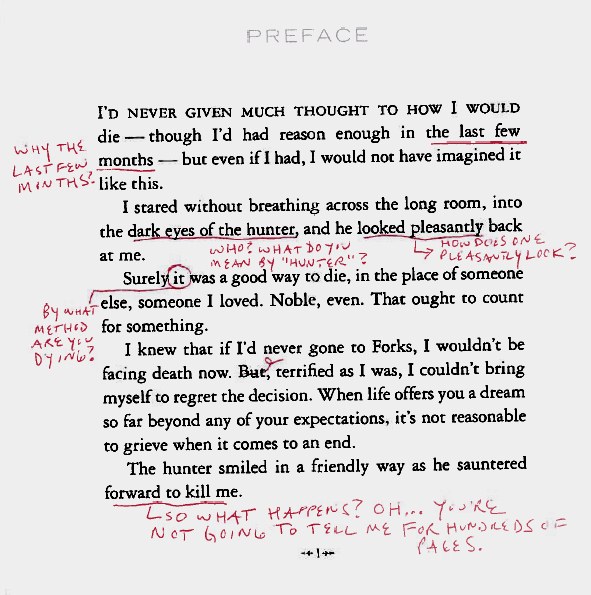 Yes, Ms. Meyer starts her story in the middle of some action, but the tension introduced by this opening scene is not going to be resolved for a very long time. Further, Ms. Meyer brings up a lot of questions and offers a great deal of vague prose. Who is this “hunter?” How is the first-person narrator about to die? Even if we’re curious about this poorly defined conflict, we have quite a way to go until we figure out what is going on.
Yes, Ms. Meyer starts her story in the middle of some action, but the tension introduced by this opening scene is not going to be resolved for a very long time. Further, Ms. Meyer brings up a lot of questions and offers a great deal of vague prose. Who is this “hunter?” How is the first-person narrator about to die? Even if we’re curious about this poorly defined conflict, we have quite a way to go until we figure out what is going on.
Think of it this way. Many parents like to record the moment they tell their children that the family is going to Disney World. Look at how happy this young lady is upon hearing the news:
Now imagine that the mother said, “We’re going to Disney World…eight years from now.”
Ms. Collins begins Catching Fire thus:
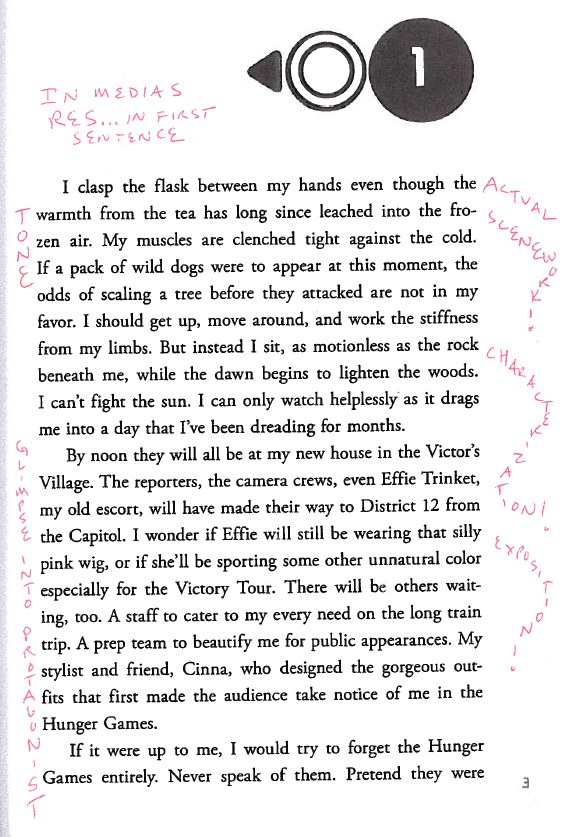
No, there is no hunter literally stalking Katniss as she reclines on the rock. There is, however, a great deal of tension. Katniss is weary. She’s sore. She needs a vacation. But Effie and the others will be around to bother her very soon. This tension will be capitalized upon very soon. More importantly, Ms. Collins doesn’t present a zillion questions that won’t be answered for a long time. The opening page also offers a great deal of characterization and contributes to the tone of the book.
7. Avoid weighing down your prose with redundant and bloated dialogue tags.
Dialogue tags are like balsa wood. They can hold things together, but you shouldn’t put too much weight on them. Look at the bloat in some of the dialogue from Twilight:
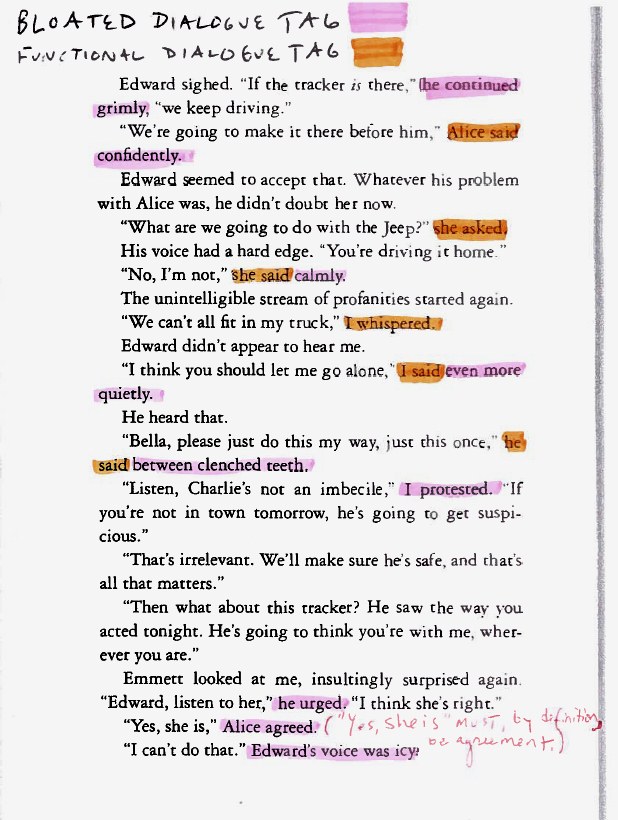 ADVERBS. SOOOOOOOOOOO MANY ADVERBS. ADVERBS EVERYWHERE, AS FAR AS THE EYE CAN SEE. Let your characters do some of the work. You’ll wear your reader down if EVERY line is modified in some way. Further, bloated dialogue tags can result in redundancies. Alice’s response at the bottom of the page is, by definition, an agreement with Emmett’s statement…but Ms. Meyer tells you again that Alice is in agreement.
ADVERBS. SOOOOOOOOOOO MANY ADVERBS. ADVERBS EVERYWHERE, AS FAR AS THE EYE CAN SEE. Let your characters do some of the work. You’ll wear your reader down if EVERY line is modified in some way. Further, bloated dialogue tags can result in redundancies. Alice’s response at the bottom of the page is, by definition, an agreement with Emmett’s statement…but Ms. Meyer tells you again that Alice is in agreement.
Allow your characters’ statements to carry the emotion. In general, you should avoid the adverb unless your character is taking a tone we wouldn’t expect from the line. For example:
“I’m so angry at you because you’re irresponsible!” Ken’s ex-girlfriend shouted angrily through her rage with her eyes in an infuriated squint.
Don’t we know that Ken’s ex-girlfriend is justifiably angry and filled with rage and fury simply based upon what she says between the quotation marks? Now look at a page of Ms. Collins’s dialogue:
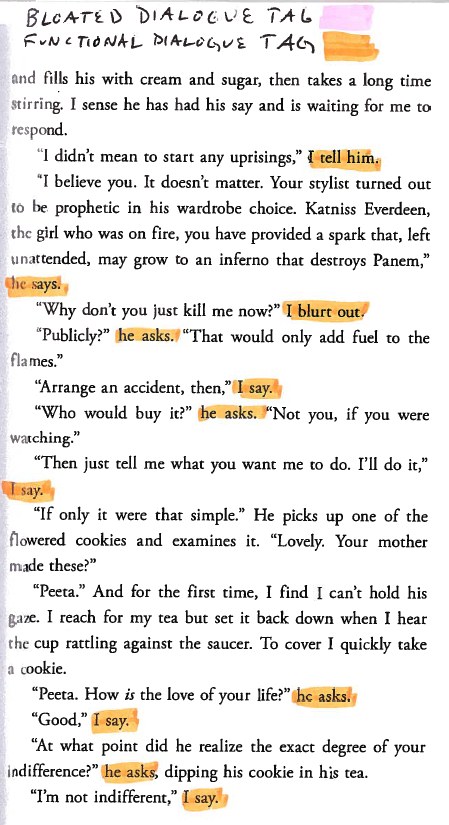 This exchange comes toward the beginning of Catching Fire. Katniss and President Snow are having a very calm argument while sizing each other up. The lines themselves do all the work and the reader doesn’t need to wade through a zillion adverbs.
This exchange comes toward the beginning of Catching Fire. Katniss and President Snow are having a very calm argument while sizing each other up. The lines themselves do all the work and the reader doesn’t need to wade through a zillion adverbs.
8. Create tension with nagging injuries instead of catastrophic ones.
Somewhat early in Catching Fire, Katniss finds herself on the wrong side of the now-electrified border fence. Ms. Everdeen knows she needs to get back home before she gets caught. Ordinarily, this is not a problem for our Girl on Fire; she’s a skilled athlete. After climbing up a tree, she makes her way across a limb. She’s almost home free when…
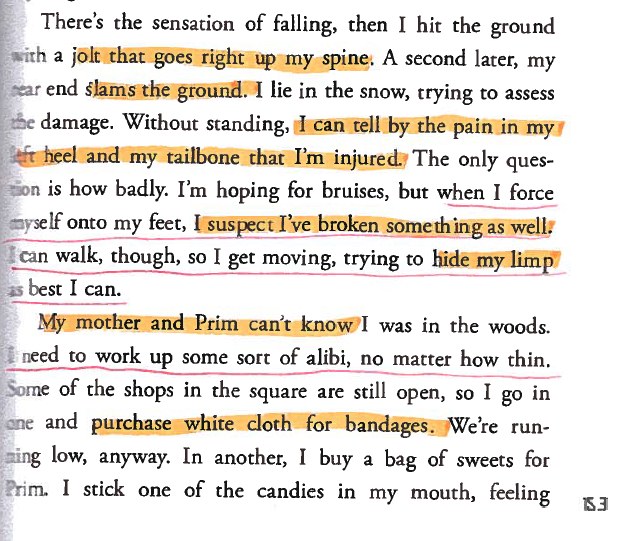 Under normal circumstances, it’s no problem for Katniss to get home and to convince the bad guys that she has been good. If anyone notices her limp, however, they will ask questions that could have problematic answers. There’s a delightful tension to the scene with the Everdeen Family and the Peacekeepers. Will someone notice Katniss is in pain? The suspense is killing me!
Under normal circumstances, it’s no problem for Katniss to get home and to convince the bad guys that she has been good. If anyone notices her limp, however, they will ask questions that could have problematic answers. There’s a delightful tension to the scene with the Everdeen Family and the Peacekeepers. Will someone notice Katniss is in pain? The suspense is killing me!
I may cry as I bring up another example…
Ordinarily, it’s no problem for Miguel Cabrera to mash the ball into the stands.
When he has a groin injury, however, long-suffering Tiger fans must suffer through a great deal of suspense that ends in heartbreak. Sigh.
9. Place your characters in a well-defined and realistic world, but avoid overwhelming your reader.
Panem doesn’t necessarily need to be more than just THE WORLD IN WHICH THE HUNGER GAMES TAKES PLACE. A ten-year-old who reads these books isn’t required to draw the kind of map I showed you in Part 1 in order to understand what is happening. That child doesn’t need to know what “panem” means. Hardcore devotees, of course, are welcome to perform complicated analyses of the economic and sociopolitical conditions in each of the Districts. Ms. Collins manages to make Katniss’s world feel real, but doesn’t force me to get a pad and paper and keep notes on everything. Here’s an example:
 Okay, so I could do the math. District 4 has a lot of waterfront property. District 3 must have a lot of factories and highly skilled engineers. District 8 is the textile center of Panem. Importantly, the sections such as these aren’t homework. All I need to know in order to enjoy the story is that each of the Districts has different resources. The world feels like a real place, even though every acre is a part of Ms. Collins’s daydream.
Okay, so I could do the math. District 4 has a lot of waterfront property. District 3 must have a lot of factories and highly skilled engineers. District 8 is the textile center of Panem. Importantly, the sections such as these aren’t homework. All I need to know in order to enjoy the story is that each of the Districts has different resources. The world feels like a real place, even though every acre is a part of Ms. Collins’s daydream.
10. Tamp down that desire to write beautiful poetry when flowery prose is inappropriate.
Ms. Collins is capable of writing some beautiful Harlan Ellison/Ray Bradbury/Jane Austen-esque sentences. The first-person protagonist of The Hunger Games, while bright, is not Shakespeare. Katniss, therefore, shouldn’t be given the kind of complicated lines that would be out of reach for someone who grew up poor in a District with poor schools. Here’s an example where I feel that Ms. Collins is balancing her ability and desire to knock you out with poetry, but balances the urge with the reality of the character she created:
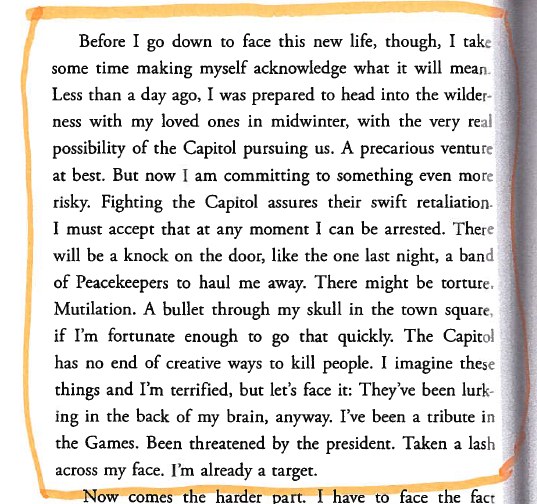 The sentences are often short. There are some killer phrases, but the diction is not too high. As always, our ultimate goal is to serve the story. In this instance, Ms. Collins served the story by holding back.
The sentences are often short. There are some killer phrases, but the diction is not too high. As always, our ultimate goal is to serve the story. In this instance, Ms. Collins served the story by holding back.
Novel
Suzanne Collins, The GWS 10, The Hunger Games, Twilight, Young Adult
Suzanne Collins rocketed onto the bestseller lists in 2008 with The Hunger Games, a post-apocalyptic adventure about a young woman compelled to participate in a life-or-death game show that was created by the government to keep citizens in line. The books are considered works of “Young Adult” literature, but their appeal reaches far beyond that single demographic. If you haven’t read the books, it might be a good idea to pick them up or to borrow them from from a young person in your life. Stephen King, master of the page-turner, called the novel a “violent, jarring speed-rap of a novel that generates nearly constant suspense and may also generate a fair amount of controversy.”
Most of us would be lying if we said we didn’t want the same kind of vast and passionate audience that Ms. Collins enjoys. Here are ten elements of craft that writers should consider stealing from the Hunger Games trilogy:
1. Treat Your Reader Like an Adult…Even When They’re Not.
The Hunger Games, is not exactly what many people would consider “appropriate” for young adults. As Mr. King points out:
And although ”young adult novel” is a dumbbell term I put right up there with ”jumbo shrimp” and ”airline food” in the oxymoron sweepstakes, how many novels so categorized feature one character stung to death by monster wasps and another more or less eaten alive by mutant werewolves?
I had much the same experience as Mr. King as I read the books. There’s a lot of death and destruction in these books. And that’s a great thing! (You know, because the books are fiction. Real life violence is a problem.) It’s hard enough to tell a story; it’s still harder when you forbid yourself from depicting the natural consequences of human failings. It’s tempting to want everything to end in a pleasant fashion and for every character to find happiness, but that’s not how the world really works. In other words…
Rue HAD to die.
2. Be Open to Inspiration From a Wide Range of Sources.
Writers must play an unending game of “what if?” Ms. Collins described her moment of inspiration for Publisher’s Weekly:
Collins says the idea for the brutal nation of Panem came one evening when she was channel-surfing between a reality show competition and war coverage. “I was tired, and the lines began to blur in this very unsettling way.” She also cites the Greek myth of Theseus, in which the city of Athens was forced to send 14 young men and women into the labyrinth in Crete to face the Minotaur. “Even as a kid, I could appreciate how ruthless this was,” Collins recalled. “Crete was sending a very clear message: ‘Mess with us and we’ll do something worse than kill you. We’ll kill your children.’ ”
Great things can happen when a writer mashes together her thoughts about increasingly outlandish reality shows, coverage of the war in Iraq and childhood history lessons. Why not flip through Edward Gibbon’s History of the Decline and Fall of the Roman Empire? The book is packed with steal-worthy stories from history.
3. Seize the Reader with the First Person Present.
One of the first things I noticed about the books was that they are written from Katniss’s perspective in present tense. (It just so happens that I’m working on a book that uses the same POV.) Here’s an excerpt of the book’s prose:
Haymitch has never seen me run. Maybe if he had he’d tell me to go for it. Get the weapon. Since that’s the very weapon that might be my salvation. And I only see one bow in that whole pile. I know the minute must be almost up and will have to decide what my strategy will be and I find myself positioning my feet to run, not away into the surrounding forests but toward the pile, toward the bow. When suddenly I notice Peeta, he’s about five tributes to my right, quite a fair distance, still I can tell he’s looking at me and I think he might be shaking his head. But the sun’s in my eyes, and while I’m puzzling over it the gong rings out.
And I’ve missed it! I’ve missed my chance! Because those extra couple of seconds I’ve lost by not being ready are enough to change my mind about going in. My feet shuffle for a moment, confused at the direction my brain wants to take and then I lunge forward, scoop up the sheet of plastic and a loaf of bread. The pickings are so small and I’m so angry with Peeta for distracting me that I sprint in twenty yards to retrieve a bright orange backpack that could hold anything because I can’t stand leaving with virtually nothing.
What does the first person POV accomplish for Ms. Collins? What does the present tense add? Well, a first-time reader knows nothing about The Hunger Games. Experiencing the spectacle through Katniss’s eyes allows us to understand what is “normal” in the book’s society. Katniss doesn’t think it’s at all strange for children to kill each other as they make a mad dash in the direction of a pile of weapons. A third person narrator would have a lot more explaining to do to bridge the gap between the world of the book and our world. Instead, Katniss just gets to tell you about her life and what she’s thinking and feeling.
The present tense adds a lot of suspense. Katniss doesn’t know how her story will end…it’s still happening to her! A reader may have unspoken assumptions that a third person narrator has access to the future. By keeping everything in the present tense, Ms. Collins gets all the more power out of Katniss’s reactions to her problems.
4. Avoid Overwheming Your Reader with the Minutiae of Your World.
I’m certainly not disputing the influence of the Lord of the Rings books and I acknowledge Tolkien’s great achievement. That said, I found it very hard to truly engage with those Middle Earth stories. It seemed to me as though reading all of those books represented an awful lot of WORK that I wasn’t willing to do. As Lee K. Abbott points out, it’s the writer’s job to do all of the work so the reader can have all of the fun. I’ve come across some other works whose authors seem to expect me to get a pad and paper so I can construct the detailed family tree that would allow me to understand the story.
The Hunger Games books, on the other hand, don’t require you to delve into the minutiae of the world of Panem. You don’t NEED to know where District 12 is located in North America. You’re not FORCED to remember how many winners have come from each District. The story is about Katniss and her struggle and Ms. Collins allows you to understand the political intrigue through her eyes, not the other way around. On the other hand, we should…
5. Create a Realistic and Complicated World as Detailed as Our Own.
Ms. Collins may or may not have gone the J.K. Rowling route, compiling a complete history of the Games and of Panem for her own benefit. What matters is that the end result FEELS real. Two very creative folks took to LiveJournal, creating as realistic a map of Panem as they could based upon the details from the books. Ms. Collins put enough love and attention into her novels that you can do this kind of detective work if you really want to.
Look at a site like PanemPropaganda. Ms. Collins created such a realistic dystopia that talented fans are able to recreate the kind of propaganda that is put out by the Capitol. These kinds of efforts are only possible because of the work Ms. Collins did to ensure that everything in the books fit together in a logical fashion and that you could actually live in the world of the book.
Continued in Part Two…
Novel
Suzanne Collins, The GWS 10, The Hunger Games, Twilight, Young Adult








